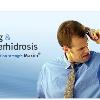

Perspiration (sweating, transpiration, or diaphoresis) is the production of a fluid consisting primarily of water as well as various dissolved solids (chiefly chlorides), that is excreted by the sweat glands in the skin of mammals. Sweat contains the chemicals or odorants 2-methylphenol (Cresol) (o-cresol) and 4-methylphenol (P-Cresol) (p-cresol), as well as a small amount of urea.
In humans, sweating is primarily a means of thermoregulation, although it has been proposed that components of male sweat can act as pheromonal (pheromone) cues. Evaporation of sweat from the skin surface has a cooling effect due to the latent heat of evaporation of water. Hence, in hot (Temperature) weather, or when the individuals muscles heat up due to exertion, more sweat is produced. Sweating is increased by nervousness and nausea and decreased by cold. Animals with few sweat glands, such as dogs, accomplish similar temperature regulation results by panting, which evaporates water from the moist lining of the oral cavity and pharynx. Primates and horses have armpits that sweat like those of humans. Although sweating is found in a wide variety of mammals, relatively few, such as humans and horses, produce large amounts of sweat in order to cool down.
Icd10: ICD10R61r50
Icd9: ICD9780.8


